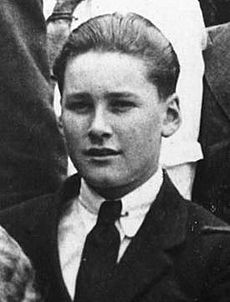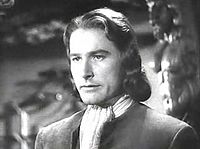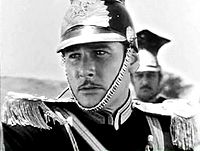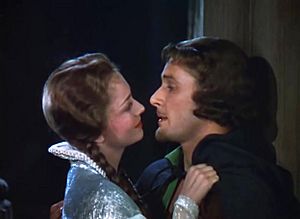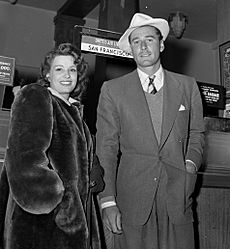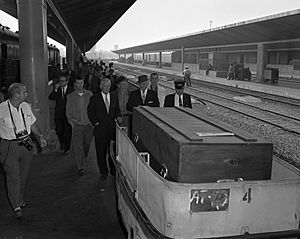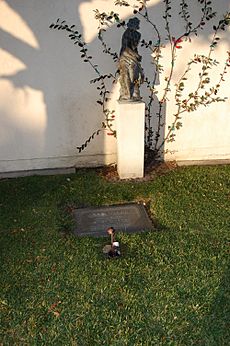Errol Flynn facts for kids
Quick facts for kids
Errol Flynn
|
|
|---|---|
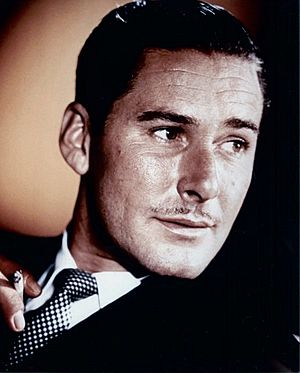
Flynn c. 1940
|
|
| Born |
Errol Leslie Thomson Flynn
20 June 1909 Battery Point, Tasmania, Australia
|
| Died | 14 October 1959 (aged 50) Vancouver, British Columbia, Canada
|
| Resting place | Forest Lawn Memorial Park, Glendale, California, U.S. |
| Nationality |
|
| Occupation | Actor |
| Years active | 1932–1959 |
| Spouse(s) |
Lili Damita
(m. 1935; div. 1942)Nora Eddington
(m. 1943; div. 1949) |
| Children | 4, including Sean Flynn |
| Parent(s) |
|
Errol Leslie Thomson Flynn (20 June 1909 – 14 October 1959) was an Australian-American actor who achieved worldwide fame during the Golden Age of Hollywood. He was known for his romantic swashbuckler roles. His most notable roles include the eponymous hero in The Adventures of Robin Hood (1938), which was later named by the American Film Institute as the 18th greatest hero in American film history, the lead role in Captain Blood (1935), Major Geoffrey Vickers in The Charge of the Light Brigade (1936), and the hero in a number of Westerns such as Dodge City (1939), Santa Fe Trail (1940), and San Antonio (1945).
Contents
Early life
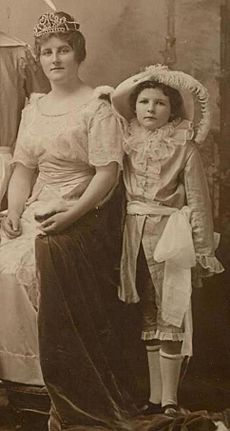
Errol Leslie Thomson Flynn was born on 20 June 1909 at Queen Alexandra Hospital in Battery Point, Tasmania. His father, Theodore Thomson Flynn, was a lecturer (1909) and later professor (1911) of biology at the University of Tasmania. His mother was born Lily Mary Young, but shortly after marrying Theodore at St John's Church of England, Birchgrove, Sydney, on 23 January 1909, she changed her first name to Marelle. Flynn described his mother's family as "seafaring folk" and this appears to be where his lifelong interest in boats and the sea originated. Both of his parents were Australian-born of Irish, English and Scottish descent.
Flynn received his early schooling in Hobart. He attended The Hutchins School, Hobart College, The Friends School and Albura Street Primary School and was expelled from each one. He made one of his first appearances as a performer in 1918, aged nine, when he served as a page boy to Enid Lyons in a queen carnival.
From 1923 to 1925, Flynn attended the South West London College, a private boarding school in Barnes, London.
In 1926, he returned to Australia to attend Sydney Church of England Grammar School (known as "Shore"), where he was the classmate of a future Australian prime minister, John Gorton.
He went to Papua New Guinea at the age of eighteen, seeking his fortune in tobacco planting and gold mining in the Morobe Goldfield. He spent the next five years oscillating between New Guinea and Sydney.
Early career
In the Wake of the Bounty
Australian filmmaker Charles Chauvel was making a film about the mutiny on the Bounty, In the Wake of the Bounty (1933), a combination of dramatic re-enactments of the mutiny and a documentary on present-day Pitcairn Island. Chauvel was looking for someone to play the role of Fletcher Christian. There are different stories about the way Flynn was cast. According to one, Chauvel saw his picture in an article about a yacht wreck involving Flynn. The most popular account is that he was discovered by cast member John Warwick. The film was not a strong success at the box office, but Flynn's was the lead role, leading him to travel to Britain in late 1933 to pursue a career in acting.
Britain
Flynn got work as an extra in a film, I Adore You (1933), produced by Irving Asher for Warner Bros. He soon secured a job with the Northampton Repertory Company at the town's Royal Theatre (now part of Royal & Derngate), where he worked and received his training as a professional actor for seven months. Northampton is home to an art-house cinema that was named after him, the Errol Flynn Filmhouse, from 2013 to 2019. He performed at the 1934 Malvern Festival and in Glasgow, and briefly in London's West End.
In 1934 Flynn was dismissed from Northampton Rep. after he threw a female stage manager down a stairwell. He returned to London. Asher cast him as the lead in Murder at Monte Carlo, a "quota quickie" made by Warner Brothers at their Teddington Studios in Middlesex. The movie was not widely seen (it is a lost film) but Asher was enthusiastic about Flynn's performance and cabled Warner Bros in Hollywood, recommending him for a contract. Executives agreed and Flynn was sent to Los Angeles.
Hollywood
On the ship from London, Flynn met (and eventually married) Lili Damita, an actress five years his senior whose contacts proved invaluable when Flynn arrived in Los Angeles. Warner Bros. publicity described him as an "Irish leading man of the London stage."
His first appearance was a small role in The Case of the Curious Bride (1935). His next part was slightly bigger, in Don't Bet on Blondes (1935), a B-picture screwball comedy.
Captain Blood
Warner Bros. was preparing a big budget swashbuckler, Captain Blood (1935), based on the 1922 novel by Rafael Sabatini and directed by Michael Curtiz.
The studio originally intended to cast Robert Donat, but he turned down the part, afraid that his chronic asthma would make it impossible for him to perform the strenuous role. Warners considered a number of other actors, including Leslie Howard and James Cagney, and also conducted screen tests of those they had under contract, like Flynn. The tests were impressive and Warners finally cast Flynn in the lead, opposite 19-year-old Olivia de Havilland. The resulting film was a magnificent success for the studio and gave birth to two new Hollywood stars and an on-screen partnership that would encompass eight films over six years. The budget for Captain Blood was $1.242 million, and it made $1.357 million in the U.S. and $1.733 million overseas, meaning a huge profit for Warner Bros.
Flynn had been selected to support Fredric March in Anthony Adverse (1936), but public response to Captain Blood was so enthusiastic that Warners instead reunited him with de Havilland and Curtiz in another adventure tale, this time set during the Crimean War, The Charge of the Light Brigade (1936). The film was given a slightly larger budget than Captain Blood, at $1.33 million, and it had a much higher box-office gross, earning $1.454 million in the US and $1.928 million overseas, making it Warner Bros.' No. 1 hit of 1936.
Flynn asked for a different kind of role and so when ill health made Leslie Howard drop out of the screen adaptation of Lloyd C. Douglas' inspirational novel, Flynn got the lead role in Green Light (1937), playing a doctor searching for a cure for Rocky Mountain Spotted Fever. The studio then put him back into another swashbuckler, replacing Patric Knowles as Miles Hendon in The Prince and the Pauper (1937). He appeared opposite Kay Francis in Another Dawn (1937), a melodrama set in a mythical British desert colony. Warners then gave Flynn his first starring role in a modern comedy, The Perfect Specimen (1937), with Joan Blondell, under the direction of Curtiz. Meanwhile, Flynn published his first book, Beam Ends (1937), an autobiographical account of his experiences sailing around Australia as a youth. He also travelled to Spain, in 1937, as a war correspondent during the Spanish Civil War, in which he sympathised with the Republicans.
The Adventures of Robin Hood
Flynn followed this with his most famous movie, The Adventures of Robin Hood (1938), playing the title role, opposite de Havilland's Marian. This movie was a global success. It was the 6th-top movie grosser of 1938. It was also the studio's first large-budget colour film using the three-strip Technicolor process. The budget for Robin Hood was the highest ever for a Warner Bros. production up to that point—$2.47 million—but it more than made back its costs and turned a huge profit as it grossed $2.343 million in the U.S. and $2.495 million overseas.
It also received lavish praise from critics and became a world favourite.
The success of The Adventures of Robin Hood did little to convince the studio that their prize swashbuckler should be allowed to do other things, but Warners allowed Flynn to try a screwball comedy, Four's a Crowd (1938). Despite the presence of de Havilland and direction of Curtiz, it was not a success.
Flynn had a powerful dramatic role in The Dawn Patrol (1938), a remake of a pre-code 1930 drama of the same name.
In 1939, Flynn and de Havilland teamed up with Curtiz for Dodge City (1939), the first Western for both of them, set after the American Civil War. Flynn was worried that audiences would not accept him in Westerns but the film was Warner's most popular film of 1939 and he went on to make a number of movies in that genre.
Second World War
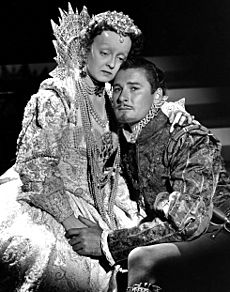

Flynn consistently ranked among Warner Bros. top stars. In 1937, he was the studio's No. 1 star, ahead of Paul Muni and Bette Davis.
Flynn became a naturalised American citizen on 14 August 1942. With the United States fully involved in the Second World War, he attempted to enlist in the armed services but failed the physical exam due to recurrent malaria (contracted in New Guinea), a heart murmur, and latent pulmonary tuberculosis. Flynn was mocked by reporters and critics as a "draft dodger" but the studio refused to admit that their star, promoted for his physical beauty and athleticism, had been disqualified due to health problems.
Flynn started a new long-term relationship with a director when he teamed with Raoul Walsh in They Died with Their Boots On (1942), a biopic of George Armstrong Custer. De Havilland was his co-star in this, the last of 8 films they made together. The movie grossed $2.55 million in the U.S. alone, making it Warner Bros.' second-biggest hit of 1942.
Flynn's first World War II film was Desperate Journey (1942), directed by Walsh, in which he played an Australian for the first time. It was another big hit.
The role of Gentleman Jim Corbett in Walsh's Gentleman Jim (1942) was one of Flynn's favourites. Warner Bros. purchased the rights to make a film of Corbett's life from his widow, Vera, specifically for their handsome, athletic and charming leading man. The movie bears little resemblance to the boxer's life, but the story was a crowd pleaser. Despite—or perhaps because of—its departure from reality, "Gentleman Jim" packed the theatres. According to Variety, it was the third Errol Flynn movie to gross at least $2 million for Warner Bros. in 1942.
Flynn eagerly undertook extensive boxing training for this film, working with Buster Wiles and Mushy Callahan. Callahan's remembrances were documented in Charles Higham's Errol Flynn: The Untold Story. "Errol tended to use his right fist. I had to teach him to use his left and to move very fast on his feet...Luckily he had excellent footwork, he was dodgy, he could duck faster than anybody I saw. And by the time I was through with him, he'd jab, jab, jab with his left like a veteran".
Flynn took the role seriously, and was rarely doubled during the boxing sequences. In The Two Lives of Errol Flynn by Michael Freedland, Alexis Smith told of taking the star aside: "'It's so silly, working all day and then playing all night and dissipating yourself. Don't you want to live a long life?' Errol was his usually apparently unconcerned self: 'I'm only interested in this half,' he told her. 'I don't care for the future.'" Flynn collapsed on set on 15 July 1942, while filming a boxing scene with Ward Bond. Filming was shut down while he recovered; he returned a week later. In his autobiography, My Wicked, Wicked Ways, Flynn describes the episode as a mild heart attack.
In Edge of Darkness (1943), set in Nazi-occupied Norway, Flynn played a Norwegian resistance fighter, a role originally intended for Edward G. Robinson. With a box office gross of $2.3 million in the U.S, it was Warner Bros.' eighth biggest movie of the year.
Post-war career
In 1946, Flynn published an adventure novel, Showdown, and earned a reported $184,000 (equivalent to $2,760,000 in 2022). Cry Wolf (1947) was a thriller with Flynn in a seemingly more villainous role. It was a moderate success at the box office. He was in a melodrama, Escape Me Never (1947), filmed in early 1946 but not released until late 1947, which lost money. More popular was a Western with Walsh and Ann Sheridan, Silver River (1948). This was a hit, although its high cost meant it was not very profitable. Flynn drank so heavily on the set that he was effectively disabled after noon, and a disgusted Walsh terminated their business relationship. Warners tried returning Flynn to swashbucklers and the result was Adventures of Don Juan (1948). The film was very successful in Europe, grossing $3.1 million, but less so in the U.S., with $1.9 million, and struggled to recoup its large budget. Still, it was Warner Bros.' 4th-biggest hit of the year. From this point on, Warner Bros. reduced the budgets of Flynn's films. In November 1947 Flynn signed a 15-year contract with Warner Bros. for $225,000 per film. His income totalled $214,000 that year, and $200,000 in 1948.
Later Warner films
After a cameo in Warner Bros.' It's a Great Feeling (1949), Flynn was borrowed by Metro-Goldwyn-Mayer to appear in That Forsyte Woman (1949) which made $1.855 million in the U.S. and $1.842 million abroad which was the 11th-biggest hit of the year for MGM. He went on a three-month holiday then made two medium budget Westerns for Warners, Montana (1950), which made $2.1 million and was Warner Bros.' 5th-biggest movie of the year, and Rocky Mountain (1950), which made $1.7 million in the U.S. and was Warner Bros.' 9th-biggest movie of the year. He returned to MGM for Kim (1950), one of Flynn's most popular movies from this period, grossing $5.348 million ($2.896 million in the U.S. plus $2.452 million abroad) making it MGM's 5th-biggest movie of the year and 11th biggest overall for Hollywood. It was shot partly in India. On his way home he shot some scenes for a film he produced, Hello God (1951), directed by William Marshall; it was never released. For many years this was considered a lost film, but in 2013 a copy was discovered in the basement of the surrogate court of New York City. Two of seven cans of the movie had deteriorated beyond hope, but five survived and are at the George Eastman House film archive for restoration.
Flynn wrote and co-produced his next film, the low-budget Adventures of Captain Fabian (1951), directed by Marshall and shot in France. (Flynn wrote articles, novels and scripts but never had the discipline to turn it into a full time career.) Flynn wound up suing Marshall over both movies. For Warners he appeared in an adventure tale set in the Philippines, Mara Maru (1952). That studio released a documentary of a 1946 voyage he had taken on his yacht, Cruise of the Zaca (1952). In August 1951 he signed a one-picture deal to make a movie for Universal, in exchange for a percentage of the profits: this was Against All Flags (1952), a popular swashbuckler. In 1952 he was seriously ill with hepatitis resulting in liver damage. In England, he made another swashbuckler for Warners, The Master of Ballantrae (1953). After that Warners ended their contract with him and their association that had lasted for 18 years and 35 films.
Europe
Flynn relocated his career to Europe. He made a swashbuckler in Italy, Crossed Swords (1954). This inspired him to produce a similar movie in that country, The Story of William Tell (1953), directed by Jack Cardiff with Flynn in the title role. The movie fell apart during production and ruined Flynn financially. Desperate for money, he accepted an offer from Herbert Wilcox to support Anna Neagle in a British musical, Lilacs in the Spring (1954). Also shot in Britain was The Dark Avenger (1955), for Allied Artists, in which Flynn played Edward, the Black Prince. Wilcox used him with Neagle again, in King's Rhapsody (1955), but it was not a success, ending plans for further Wilcox-Flynn collaborations. In 1956 he presented and sometimes performed in the television anthology series The Errol Flynn Theatre that was filmed in Britain.
Hollywood comeback
Flynn received an offer to make his first Hollywood film in five years: Istanbul (1957), for Universal. He made a thriller shot in Cuba, The Big Boodle (1957), then had his best role in a long time in the blockbuster The Sun Also Rises (1957) for producer Darryl F. Zanuck which made $3 million in the U.S. Flynn's performance in the latter was well received and led to a series of roles where he played drunks. Warner Bros. cast him as John Barrymore in Too Much, Too Soon (1958), and Zanuck used him again in The Roots of Heaven which made $3 million (1958). He met with Stanley Kubrick to discuss a role in Lolita, but nothing came of it. Flynn went to Cuba in late 1958 to film the self-produced B film Cuban Rebel Girls, where he met Fidel Castro and was an enthusiastic supporter of the Cuban Revolution. He wrote a series of newspaper and magazine articles for the New York Journal American and other publications documenting his time in Cuba with Castro. Flynn was the only journalist who happened to be with Castro the night Batista fled the country and Castro learned of his victory in the revolution. Many of these pieces were lost until 2009, when they were rediscovered in a collection at the University of Texas at Austin's Dolph Briscoe Center for American History. He appeared in a short titled Cuban Story: The Truth About Fidel Castro Revolution (1959), his last-known work.
Personal life
Marriages and family
Flynn was married three times: to actress Lili Damita from 1935 until 1942 (one son, Sean Flynn); to Nora Eddington from 1943 to 1949 (two daughters, Deirdre and Rory); and to actress Patrice Wymore from 1950 until his death (one daughter, Arnella Roma). Errol is the grandfather to actor Sean Flynn (via Rory), who starred in the TV series Zoey 101.
After quitting Hollywood, Flynn lived with Wymore in Port Antonio, Jamaica in the early 1950s. He was largely responsible for developing tourism to this area and for a while owned the Titchfield Hotel which was decorated by the artist Olga Lehmann. He popularised trips down rivers on bamboo rafts.
His only son, Sean (born 31 May 1941), was an actor and war correspondent. He and his colleague Dana Stone disappeared in Cambodia in April 1970 during the Vietnam War, while both were working as freelance photojournalists for Time magazine. After a decade-long search financed by his mother, Sean was officially declared dead in 1984. Sean's life is recounted in the book Inherited Risk: Errol and Sean Flynn in Hollywood and Vietnam.
Death
By 1959, Flynn's financial difficulties had become so serious that he flew on 9 October to Vancouver, British Columbia, to negotiate the lease of his yacht Zaca to the businessman George Caldough. As Caldough was driving Flynn to the airport on 14 October for a Los Angeles–bound flight, Flynn began complaining of severe pain in his back and legs. Caldough transported him to the residence of a doctor, Grant Gould, who noted that Flynn had considerable difficulty navigating the building's stairway. Gould, assuming that the pain was due to degenerative disc disease and spinal osteoarthritis, administered 50 milligrams of demerol intravenously.
Gould then performed a leg massage in the apartment's bedroom and advised Flynn to rest there before resuming his journey. Flynn responded that he felt "ever so much better". After 20 minutes Aadland checked on Flynn and discovered him unresponsive. Despite immediate emergency medical treatment from Gould and a swift transfer by ambulance to Vancouver General Hospital, he did not regain consciousness and was pronounced dead that evening. The coroner's report and the death certificate noted the cause of death as myocardial infarction due to coronary thrombosis and coronary atherosclerosis, with fatty degeneration of liver and portal cirrhosis of the liver significant enough to be listed as contributing factors. Flynn was survived by both his parents.
Flynn was buried at Forest Lawn Memorial Park Cemetery in Glendale, California, a place he once remarked that he hated, with six bottles of his favourite whiskey.
Filmography
Select radio performances
Flynn appeared in numerous radio performances:
| Year | Title | Venue | Dates performed |
|---|---|---|---|
| 1937 | Captain Blood | Lux Radio Theatre | 22 February |
| 1937 | British Agent | Lux Radio Theatre | 7 June |
| 1937 | These Three | Lux Radio Theatre | 6 December |
| 1938 | Green Light | Lux Radio Theatre | 31 January |
| 1939 | The Perfect Specimen | Lux Radio Theatre | 2 January |
| 1939 | Lives of a Bengal Lancer | Lux Radio Theatre | 10 April |
| 1940 | Trade Winds | Lux Radio Theatre | 4 March |
| 1941 | Virginia City | Lux Radio Theatre | 26 May |
| 1941 | They Died With Their Boots On | Cavalcade of America | 17 November |
| 1944 | Command Performance | Armed Forces Radio Network | 30 July |
| 1946 | Gentleman Jim | Theatre of Romance | 5 February |
| 1952 | Kim | Lux Radio Theatre | 18 February |
| 1952 | The Modern Adventures of Casanova | Mutual radio series | 39 episodes |
Theatre performances
Flynn appeared on stage in a number of performances, particularly early in his career:
- The Thirteenth Chair – Dec 1933 – Northampton Rep
- Jack and the Beanstalk – Dec 1933 – Northampton Rep
- Sweet Lavender – January 1934 – Northampton Rep
- Bulldog Drummond – January 1934 – Northampton Rep
- A Doll's House – January 1934 – Northampton Rep
- On the Spot – January 1934 – Northampton Rep
- Pygmalion – January–February 1934 – Northampton Rep
- Crime at Blossoms – February 1934 – Northampton Rep
- Yellow Sands – February 1934 – Northampton Rep
- The Grain of Mustard Seed – February 1934 – Northampton Rep
- Seven Keys to Baldpate – March 1934 – Northampton Rep
- Othello – March 1934 – Northampton Rep
- The Green Bay Tree – March 1934 – Northampton Rep
- The Fake – March 1934 – Northampton Rep
- The Farmer's Wife – March–April 1934 – Northampton Rep
- The Wind and the Rain – April 1934 – Northampton Rep
- Sheppey – April 1934 – Northampton Rep
- The Soul of Nicholas Snyders – April 1934 – Northampton Rep
- The Devil's Disciple – May 1934 – Northampton Rep
- Conflict – May 1934 – Northampton Rep
- Paddy the Next Best Thing – May 1934 – Northampton Rep
- 9:45 – May–June 1934 – Northampton Rep
- Malvern festival – July–August 1934 – appeared in A Man's House, History of Dr Faustus, Marvelous History of Saint Bernard, The Moon in Yellow River, Mutiny
- A Man's House – August – September1934 – Glasgow, St Martin's Lane
- Master of Thornfield – February 1958 – adaptation of Jane Eyre
See also
 In Spanish: Errol Flynn para niños
In Spanish: Errol Flynn para niños


